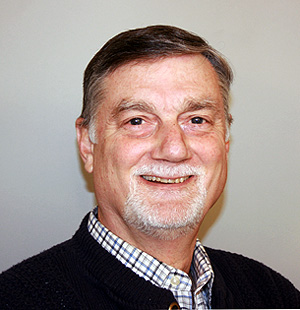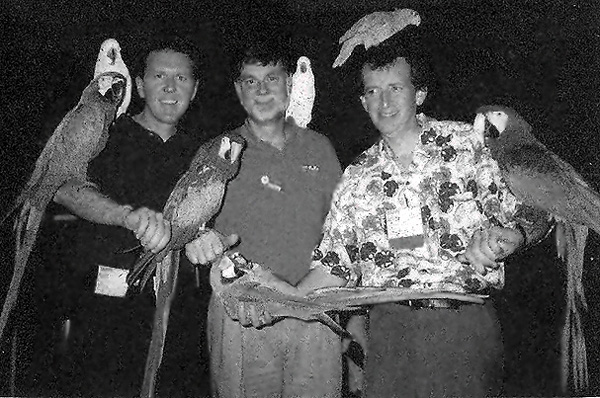Ed Robie Trades Event Planning for Farming
![]() Print this Article | Send to Colleague
Print this Article | Send to Colleague
 After 30 years with TAPPI, Ed Robie is ready to plan his biggest "event" so far: retiring with his wife Kate to their Kentucky farm. He’ll face a host of new challenges in his new hobby—raising alpacas—and may even draw on some of the skills he honed over his successful career.
After 30 years with TAPPI, Ed Robie is ready to plan his biggest "event" so far: retiring with his wife Kate to their Kentucky farm. He’ll face a host of new challenges in his new hobby—raising alpacas—and may even draw on some of the skills he honed over his successful career.Robie says his years as a TAPPI meetings and event planner were always interesting. "The uniqueness of being a meeting planner is that every year it’s a new job. You’re dealing with a different venue, different people in the hospitality world, and you get to see the country—especially "mill country," which are parts of the U.S. I really like, since I’m a forester by education and a meeting planner by profession," he says.
Born and raised in Massachusetts, Robie graduated from the University of Georgia, Athens, in 1971. His first job was in the U.S. Army, where he spent three years assigned to the Military Personnel Center in Washington, D.C. He joined the staff of the Society of American Foresters (SAF) in 1974.
"At SAF, I worked with volunteers to arrange the SAF annual convention—that’s how I got started in event planning," says Robie. "I knew about TAPPI, of course. I remember I once picked up Phil Nethercut (then TAPPI’s CEO) at Washington National airport in my Triumph TR6 convertible! I was with SAF for nine years; that’s how I met Kate, who was in woodlands management with Westvaco at the time."
Ed brought his event planning experience and his forestry background (but not his TR6) to TAPPI when he joined the staff in 1984 as a meeting administrator. He worked his way through successive positions until June 2006 when, as event project manager, he retired for the first time from TAPPI. That year, Ed also received the Engineering Division’s Leadership Award.
"When Larry formally hired me back on a part-time basis in 2008, I concentrated on the meetings I’d already had a lot of experience in: Engineering; EPE, which is now PEERS; and now of course PaperCon," Robie says.
Today, Ed and Kate Robie live at Ash Hill Farm in Kentucky, where they raise alpacas. Alpacas are domesticated herd animals originating in Peru; they are similar to llamas and are raised chiefly for their wool. The Robies became interested in the animals a few years ago after visiting the New Jersey alpaca ranch of a family friend.
"We always wanted to live in the country when we retired," Robie says. Kate has family in Kentucky, and the Robies scouted for "quite a long time" to find the perfect property: 30 acres south of Versailles, Ky. They moved to the area in 2012.
"We worked with an architect in Lexington to help us plan our dream home," Robie says. "We moved in just before Thanksgiving of 2014."
The couple purchased their first alpacas while still living in Georgia from a farm near Dawsonville. As a fiber artist who knits and spins wool, Kate fell in love with the unique alpaca fiber. Today, the Ash Hill herd includes eleven alpacas and two llamas, which are larger and serve as "guard animals" for the herd.
Robie chuckles when asked if there are any similarities between herding alpacas and planning TAPPI events. "Well, alpacas do as they’re told!" he laughs. "Also, there are no committees, but somehow alpacas figure out how to get along."
Robie also volunteers at the Aviation Museum of Kentucky. "Aviation has always been an interest of mine; I don’t fly myself, but my son Jack and his wife are both Navy pilots." Daughter Meg is a landscape architect in the Atlanta area.
Ash Hill Farm is a member of Kentucky Proud, a farmer’s association supported by the Kentucky Agricultural Department; and also a member of Homegrown by Heroes, a group for veterans who are farmers. The Robies are also members of the Kentucky Alpaca Association—which Robie says is a great way to learn more about their hobby and meet people with similar interests. "TAPPI puts on meetings, but KAA puts on alpaca shows," he quips.
Involvement with these organizations reminds Robie of what he finds most memorable about his TAPPI years. "TAPPI is a people organization," he says. "One thing I’ve really enjoyed is the life-long friendships I’ve made with volunteers and TAPPI employees. That has made it very rewarding for me."

The Architecture of a Good Meeting
When Ed and Kate Robie decided to build their dream home for his retirement in rural Kentucky, they had an inking of what to expect—Ed’s years as a meeting planner gave him unique insight into the process. Planning a successful meeting has a lot in common with building that perfect home, as Ed explains in his own words below.
"Meeting and event planning is kind of like an architectural team that designs a house or building and sees the project through to completion," says Ed. "To build the house or building, you create a final set of plans (on paper, of course) and work with your team of designers and contractors. It’s a great feeling of accomplishment when the house or building is completed.
"Meeting planning starts with checking out potential venues several years ahead of time, deciding on the best venue, and going to contract. The real work starts after the most recent meeting has completed and the team is in place to plan the next year’s conference (this is like the architectural board). The plan takes shape with staff and volunteers during the next nine months or so. Technical sessions are developed, exhibiting companies sign up to exhibit, other meeting details come together. Finally, the ‘blueprints’ are finished, the details are communicated to the meeting venue, the ‘house’ is built, and the meeting takes place.
"That’s when you have that feeling of accomplishment. Your ‘contractors’—hotel, food and beverage, audio-visual, transportation, exhibit service providers, and others—are doing a great job. Attendees are in sessions; the exhibit is set up; and attendees are visiting exhibitors, networking and enjoying the receptions and coffee breaks. Then it’s over and time to get started on the next building project."
Photos: (above right) Ed Robie 2015; (below) Robie, center, with two others at 1998 TAPPI Engineering Conference.


